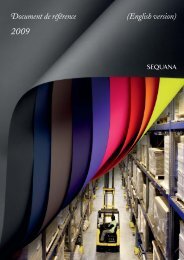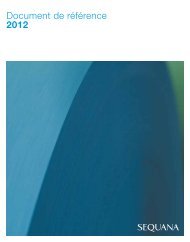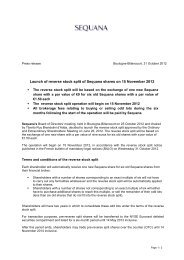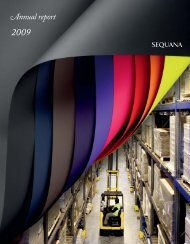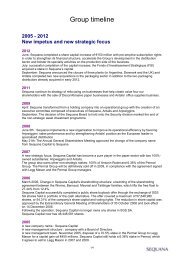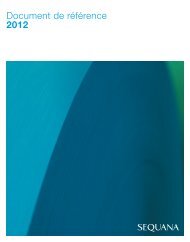Contents
Registration document PDF - Sequana
Registration document PDF - Sequana
Create successful ePaper yourself
Turn your PDF publications into a flip-book with our unique Google optimized e-Paper software.
6Corporate social responsibilityAt both Arjowiggins and Antalis, questionnaires were introducedto assess suppliers’ CSR and supply chain practices. ForAntalis, these questionnaires were sent out to suppliers togetherrepresenting 95% of the company’s paper and cardboard purchases.For Arjowiggins, the questionnaires were sent out to supplierstogether accounting for all central purchases.Identifying high-risk sources of supply must however be accompaniedby better management of traceability and procurementacross the Group. A system for managing data on the origin ofproducts, their regulatory compliance and supplier transparencyis in process and should be introduced at Antalis in 2013.6.11 - Raw material consumptionWater supply in accordance with local requirementsSignificant quantities of water are needed to make paper – mainlyfor the drying process. Depending on the plants concerned andtypes of papers manufactured, between 80% and 98% of the waterused is returned downstream to the source (river, groundwater orpublic network). However, reducing the volume of water used is aconstant concern for the Group. In summer, local authorities mayrestrict the volume of water drawn due to water stress. In closecooperation with these authorities (French Regional Directoratefor Environment, Urban Planning and Housing – DREAL),the plants must in such cases scale back their paper production.Identifying where water consumption can be reduced in the manufacturingprocess is therefore critical and will be one of the prioritiesof the working group specifically set up to look at waterissues in the coming year.Total 2012✓ (kilotonnes) Total 2011 (kilotonnes) (2)Total fibrous materials (pulp, waste paper, cotton) 1,136.4 1,064.4Total binders (latex, starch, polyvinyl acetate) 73.5 76.5Dyes/pigments/optical brighteners 4.8 4Organic loads 348.9 393.3Banknote security features 1.7 1.1Other chemical products (1) 41.4 43.9(1) PP (polypropylene), H 2O 2(hydrogen peroxide), AKD (alkyl ketene dimer), NaOH (sodium hydroxide), TiO 2(titanium dioxide), PAC (polyaluminium chloride).(2) Due to an error in the reporting procedure, the information for 2011 has been rectified for the purpose of this report.Climate change mitigation and adaptationIncreasing its use of renewable sources of energy and improvingits own energy performance are the two lynchpins of the Group’senergy policy. With its project to generate heat from biomass(wood chips) at its Palalda plant in France in 2012, the Grouphas shown clear proof of its determination to reduce its dependenceon fossil fuels and lighten its environmental footprint.Arjowiggins Graphic has been chosen to pilot the energy efficiencyproject and the main areas for improvement are currentlybeing assessed. These initiatives will subsequently be rolled out toArjowiggins’ other divisions.Although production activities account for the bulk of energyconsumed by the Group, Antalis’ distribution centres across theglobe also have a part to play. To identify the energy requirementsof its distribution business along with any potential areasfor improvement, a centralised reporting system based on theenergy consumed by major warehouses was introduced in 2012. Itfound that the Group’s distribution business accounts for 1.8% ofthe total energy consumed by the Group.Protection of biodiversityThe Group’s concern for protecting biodiversity is an integral partof its policy and is underscored by two different projects that seekto (i) improve the quality of water discharged from productionsites and (ii) ensure the traceability of its pulp and paper supplies.The large majority of the Group’s paper production plants drawthe water they need in the manufacturing process (cooling, drying,etc.) from nearby rivers and streams. The Group must takeinto consideration the ecosystems existing in these rivers.By strictly respecting regulatory effluent thresholds (suspendedsolids, chemical oxygen demand, biochemical oxygen demand,nitrogen, phosphorus, nitrogen oxide), the paper productionplants ensure that the quality of water discharged downstreaminto rivers is at least equivalent to the quality of the waterupstream. This ensures that production activities have a minimalimpact on river fauna and flora and on the associated ecosystems.Each plant measures water quality twice daily and these measurementsare regularly verified by the local authorities. To supportits ongoing efforts to reduce Sequana’s carbon footprint, aworking group will be set up in 2013 to consider the issue ofwastewater quality.Selecting responsibly-sourced supplies can also contribute to protectingbiodiversity. By chiefly purchasing pulp (Arjowiggins)and paper (Antalis) certified by the Forest Stewardship Council(FSC) or the Pan European Forest Certification (PEFC) council,the Group also reduces its impact on the natural environment.FSC and PEFC certification provide tangible guaranteesalong the entire value chain that forests were managed responsiblyat the outset. Responsible management respects environmental,social and governance criteria. To obtain these accreditations,entities must therefore respect biodiversity and ecosystems.208 | Sequana | 2012 Document de référence (English version)



